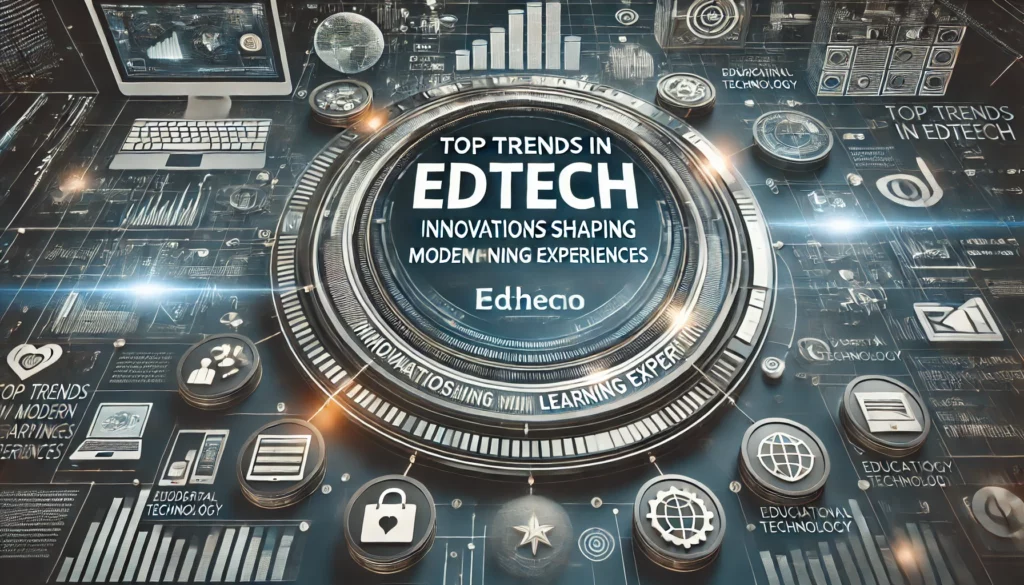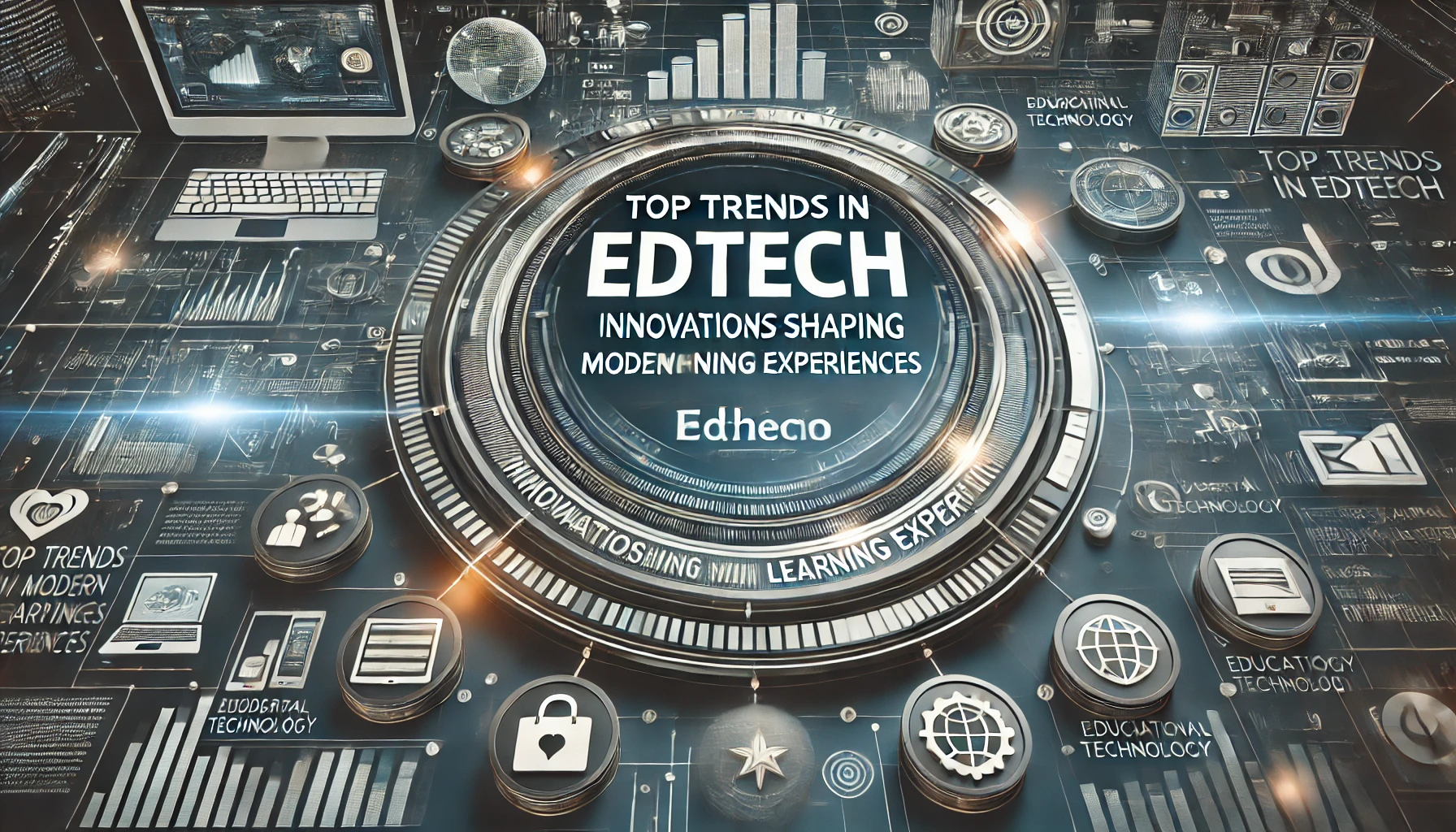
In the fast-paced world of education, technological innovations are continuously reshaping the way students and educators interact. As schools and universities adapt to the evolving digital landscape, EdTech is playing a pivotal role in shaping modern experiences. The latest trends in educational technology are creating more engaging, accessible, and effective learning environments for students worldwide. In this article, we’ll explore the top trends in EdTech that are revolutionizing education.
The Rise of Artificial Intelligence in Education
Top EdTech trends Artificial Intelligence (AI) is arguably one of the most transformative forces in the education sector. AI-powered tools are helping educators to personalize learning experiences, assess student performance, and provide tailored feedback. AI-driven chatbots are improving student engagement by providing instant assistance.
AI for Personalized Learning
AI technology is enabling personalized learning at an unprecedented scale. Adaptive learning platforms use algorithms to adjust the difficulty level of content based on individual student progress. This allows learners to engage with materials at their own pace and receive support tailored to their needs.
AI in Administrative Efficiency
On the administrative side, AI is helping schools streamline administrative tasks, such as grading and scheduling. Automated systems can handle repetitive tasks, giving educators more time to focus on teaching and improving student outcomes.
Virtual and Augmented Reality: Bringing Learning to Life
Top EdTech trends Virtual Reality (VR) and Augmented Reality (AR) are increasingly being incorporated into classrooms to create immersive learning experiences. These technologies offer students the opportunity to experience complex concepts in a hands-on, engaging.
Virtual Reality for Experiential Learning
VR enables students to virtually explore environments that would otherwise be inaccessible. For example, students can take virtual field trips to historical sites or outer space, or even conduct lab experiments in a safe, controlled virtual environment. This kind of experiential learning fosters a deeper understanding of the subject matter.
Augmented Reality in Classroom Activities
AR enhances the classroom by superimposing digital elements onto the physical world. Students can interact with 3D models of anatomical structures, historical artifacts, or even mathematical equations, making abstract concepts more tangible and easier to understand.
Gamification: Making Learning Fun and Engaging
Top EdTech trends Gamification involves incorporating game-like elements, such as points, badges, and leaderboards, into the learning process to make education more engaging and motivating. It taps into students’ natural inclination for competition and achievement, transforming boring subjects into exciting challenges.
Gamified Learning Platforms
Many educational platforms are using gamification to increase student engagement. For instance, platforms like Kahoot! and Quizlet turn studying into a game by adding quizzes, interactive lessons, and rewards for progress, enjoyable for learning
Increased Motivation through Rewards and Challenges
By integrating levels, achievements, and rewards into the learning experience, students are more motivated to reach milestones. This approach fosters a sense of accomplishment and encourages continuous learning.
Learning Management Systems (LMS) and Online Course Platforms
Top EdTech trends Learning Management Systems and online course platforms are becoming increasingly popular, offering educators & students learning and teaching. These platforms enable institutions to deliver courses remotely, manage student progress, and facilitate interaction between teachers and students.
The Power of Online Learning
The demand for online education has skyrocketed in recent years, and LMS platforms such as Moodle and Canvas are supporting this shift. These systems allow for asynchronous learning, where students can access materials and complete assignments at their own pace, making education more accessible for non-traditional learners.
Integration with Other EdTech Tools
LMS platforms are integrating with other EdTech tools, such as video conferencing apps and digital textbooks, to provide a comprehensive learning environment. This seamless integration helps ensure a smooth learning experience for students and teachers alike.
Blockchain Technology in Education
Top EdTech trends the technology behind cryptocurrencies, is gaining traction in the education sector, particularly in the areas of credentialing and record-keeping. Blockchain offers a secure and transparent way to store educational credentials and certifications, preventing fraud and ensuring the authenticity of academic achievements.
Digital Credentials and Certifications
With blockchain, students can store their diplomas, certificates, and transcripts in a secure, tamper-proof digital wallet. This can simplify the process of verifying academic records for potential employers and educational institutions, reducing administrative workload and potential errors.
Blockchain for Secure Learning Environments
Blockchain technology can also improve the security of online learning environments by ensuring that student data is encrypted and protected from unauthorized access.
The Shift Towards Collaborative Learning
Modern EdTech tools are also encouraging collaboration among students. Online collaboration tools, such as Google Workspace, Microsoft Teams, and Slack, are fostering teamwork and communication between students, no matter where they are located.
Real-Time Collaboration Tools
Through platforms that allow for real-time collaboration, students can work together on projects, share ideas, and provide peer feedback. This approach mimics the modern work environment and prepares students for the collaborative nature of professional careers.
Global Classrooms and Cultural Exchange
Technology has also enabled global classrooms, where students from different parts of the world can come together to learn, share ideas, and discuss issues from diverse perspectives. This international collaboration fosters cross-cultural understanding and prepares students for a globalized workforce.
Big Data and Learning Analytics
The use of big data and learning analytics is enabling educators to make data-driven decisions and tailor instruction to meet the needs of individual students. By analyzing vast amounts of data from student assessments, interactions, and behaviors, teachers can identify patterns and intervene when necessary.
Tracking Student Performance
Learning analytics can track student performance in real time, providing educators with valuable insights into areas where students may be struggling. This allows for timely interventions and personalized support to ensure academic success.
Predictive Analytics for Student Success
Predictive analytics uses historical data to forecast student outcomes, helping educators identify students at risk of falling behind. By acting on these insights, schools can implement strategies to keep students on track and improve graduation rates.
Cloud Computing: Flexibility and Accessibility
Cloud computing has revolutionized the way educational content is delivered and accessed. Cloud-based platforms allow students and educators to access materials, collaborate on projects, and store data remotely, making education more flexible and accessible than ever before.
Access to Learning Anytime, Anywhere
With cloud-based systems, students can access course materials, assignments, and lectures at any time, from any device. This flexibility is especially beneficial for students who may have other commitments or who are located in remote areas.
Cloud Storage for Educational Resources
Educational institutions are using the cloud to store and share resources like lectures, study materials, and multimedia content. This ensures that resources are easily accessible and can be updated in real time.
5G and Its Impact on Education
The rollout of 5G technology is set to revolutionize online learning. With faster internet speeds and lower latency, 5G will allow for seamless video conferencing, real-time collaboration, and immersive experiences like VR and AR without the lag that has historically hindered these technologies.
Enhanced Streaming and Remote Learning
5G technology will improve the quality of online education by enhancing video and audio quality during live classes and lectures. This will allow for smoother communication between students and instructors, even in areas with limited internet connectivity.
Better Access to Digital Tools
With 5G, students and educators will be able to access and utilize digital tools more effectively, ensuring that educational technology can reach its full potential.
Conclusion: Embracing the Future of Learning
As technology continues to advance, the future of education looks more promising than ever. With AI, VR, gamification, blockchain, and a host of other innovations, EdTech is transforming the way we teach and learn. These trends are making education more personalized, accessible, and engaging, ensuring that students are better prepared for the challenges of the future.
Incorporating these cutting-edge technologies into educational settings will continue to foster a learning environment that is both dynamic and effective. The integration of these trends is creating a new era in education, where technology and innovation play a crucial role in shaping the learning experiences of tomorrow.
FAQs
- How is AI changing education? AI is revolutionizing education by enabling personalized learning, automating administrative tasks, and providing valuable insights through learning analytics.
- What is the role of gamification in education? Gamification enhances engagement and motivation by incorporating game-like elements such as points, badges, and rewards into the learning process.
- How does Virtual Reality benefit education? VR allows students to experience immersive, hands-on learning environments that make complex concepts easier to understand and more engaging.
- What is blockchain’s impact on educational credentials? Blockchain technology offers a secure, transparent way to store and verify educational credentials, reducing fraud and simplifying the verification process.
- What can we expect from 5G in education? 5G will improve online learning by providing faster internet speeds, reducing lag in video conferences, and supporting immersive technologies like VR and AR.
Read More :
